The Significance of Employee Relations for Organizational Performance
VerifiedAdded on 2022/09/11
|11
|2574
|19
Report
AI Summary
This report delves into the critical relationship between employee relations and organizational performance. It begins by highlighting the significance of employee relations, emphasizing its impact on productivity and overall organizational success, supported by various research papers and books. The report explores methodologies using secondary data, including peer-reviewed articles, and discusses the relationship between employer-employee dynamics and organizational outcomes. It provides examples like IKEA to illustrate the importance of performance management and employee motivation. The report covers key theories, such as scientific management and human relations theories, and examines how organizations can enhance employee relations through strategies like employee empowerment, effective communication, and fair treatment, ultimately contributing to a motivated workforce and improved performance. The report concludes by emphasizing the need for management to adopt strategies that foster employee satisfaction, welfare, and motivation to ensure organizational success.
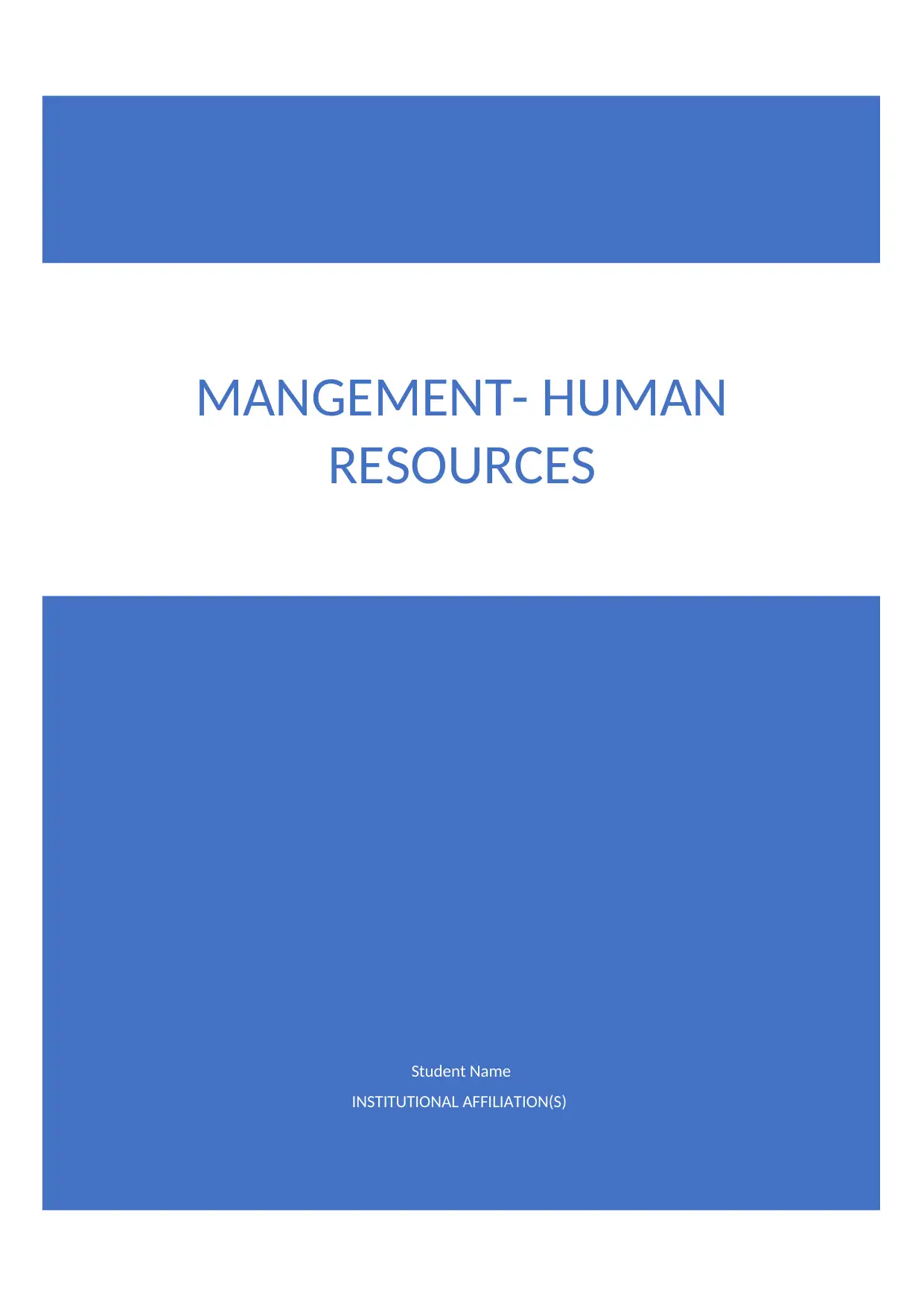
Student Name
INSTITUTIONAL AFFILIATION(S)
MANGEMENT- HUMAN
RESOURCES
INSTITUTIONAL AFFILIATION(S)
MANGEMENT- HUMAN
RESOURCES
Paraphrase This Document
Need a fresh take? Get an instant paraphrase of this document with our AI Paraphraser
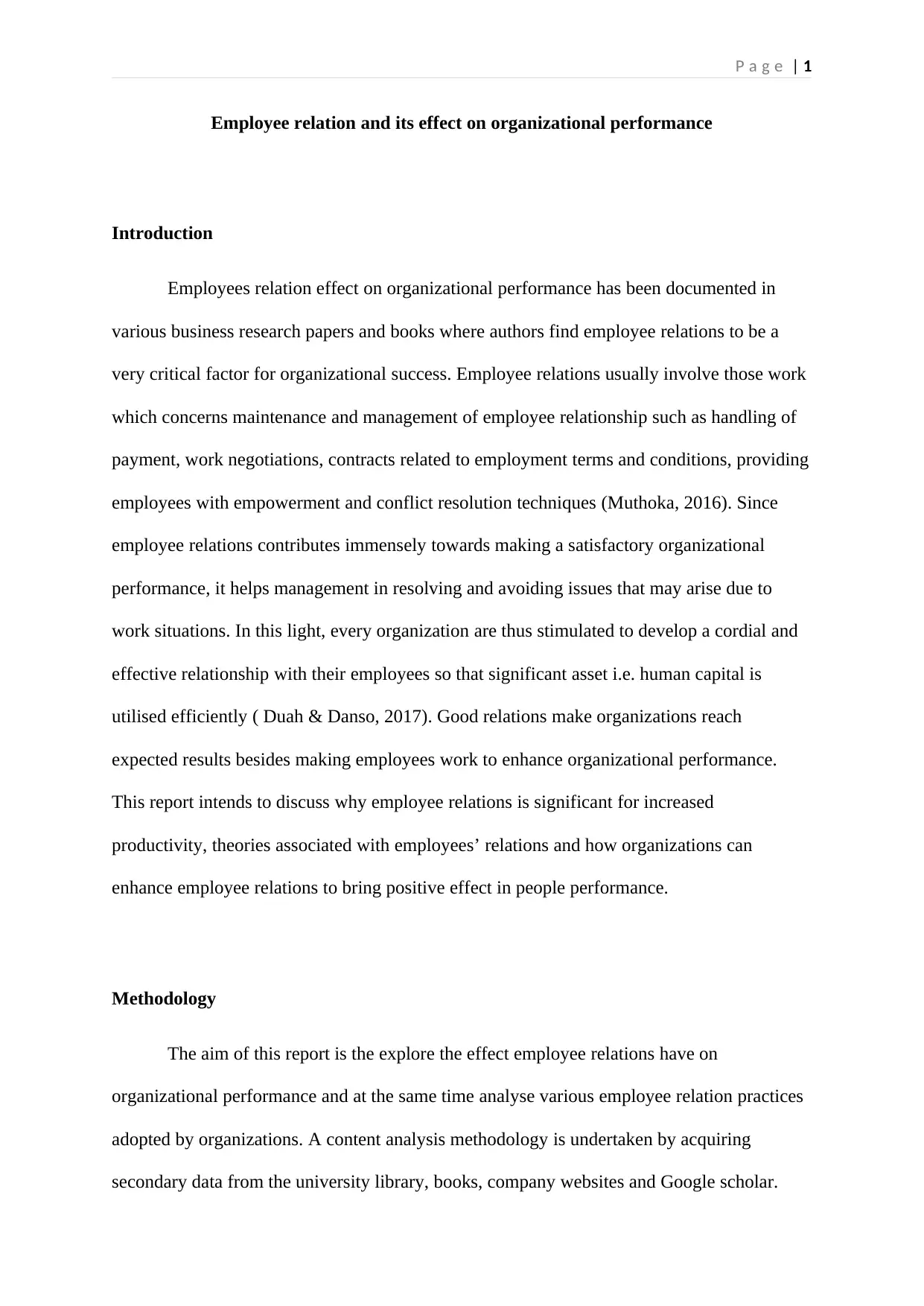
P a g e | 1
Employee relation and its effect on organizational performance
Introduction
Employees relation effect on organizational performance has been documented in
various business research papers and books where authors find employee relations to be a
very critical factor for organizational success. Employee relations usually involve those work
which concerns maintenance and management of employee relationship such as handling of
payment, work negotiations, contracts related to employment terms and conditions, providing
employees with empowerment and conflict resolution techniques (Muthoka, 2016). Since
employee relations contributes immensely towards making a satisfactory organizational
performance, it helps management in resolving and avoiding issues that may arise due to
work situations. In this light, every organization are thus stimulated to develop a cordial and
effective relationship with their employees so that significant asset i.e. human capital is
utilised efficiently ( Duah & Danso, 2017). Good relations make organizations reach
expected results besides making employees work to enhance organizational performance.
This report intends to discuss why employee relations is significant for increased
productivity, theories associated with employees’ relations and how organizations can
enhance employee relations to bring positive effect in people performance.
Methodology
The aim of this report is the explore the effect employee relations have on
organizational performance and at the same time analyse various employee relation practices
adopted by organizations. A content analysis methodology is undertaken by acquiring
secondary data from the university library, books, company websites and Google scholar.
Employee relation and its effect on organizational performance
Introduction
Employees relation effect on organizational performance has been documented in
various business research papers and books where authors find employee relations to be a
very critical factor for organizational success. Employee relations usually involve those work
which concerns maintenance and management of employee relationship such as handling of
payment, work negotiations, contracts related to employment terms and conditions, providing
employees with empowerment and conflict resolution techniques (Muthoka, 2016). Since
employee relations contributes immensely towards making a satisfactory organizational
performance, it helps management in resolving and avoiding issues that may arise due to
work situations. In this light, every organization are thus stimulated to develop a cordial and
effective relationship with their employees so that significant asset i.e. human capital is
utilised efficiently ( Duah & Danso, 2017). Good relations make organizations reach
expected results besides making employees work to enhance organizational performance.
This report intends to discuss why employee relations is significant for increased
productivity, theories associated with employees’ relations and how organizations can
enhance employee relations to bring positive effect in people performance.
Methodology
The aim of this report is the explore the effect employee relations have on
organizational performance and at the same time analyse various employee relation practices
adopted by organizations. A content analysis methodology is undertaken by acquiring
secondary data from the university library, books, company websites and Google scholar.
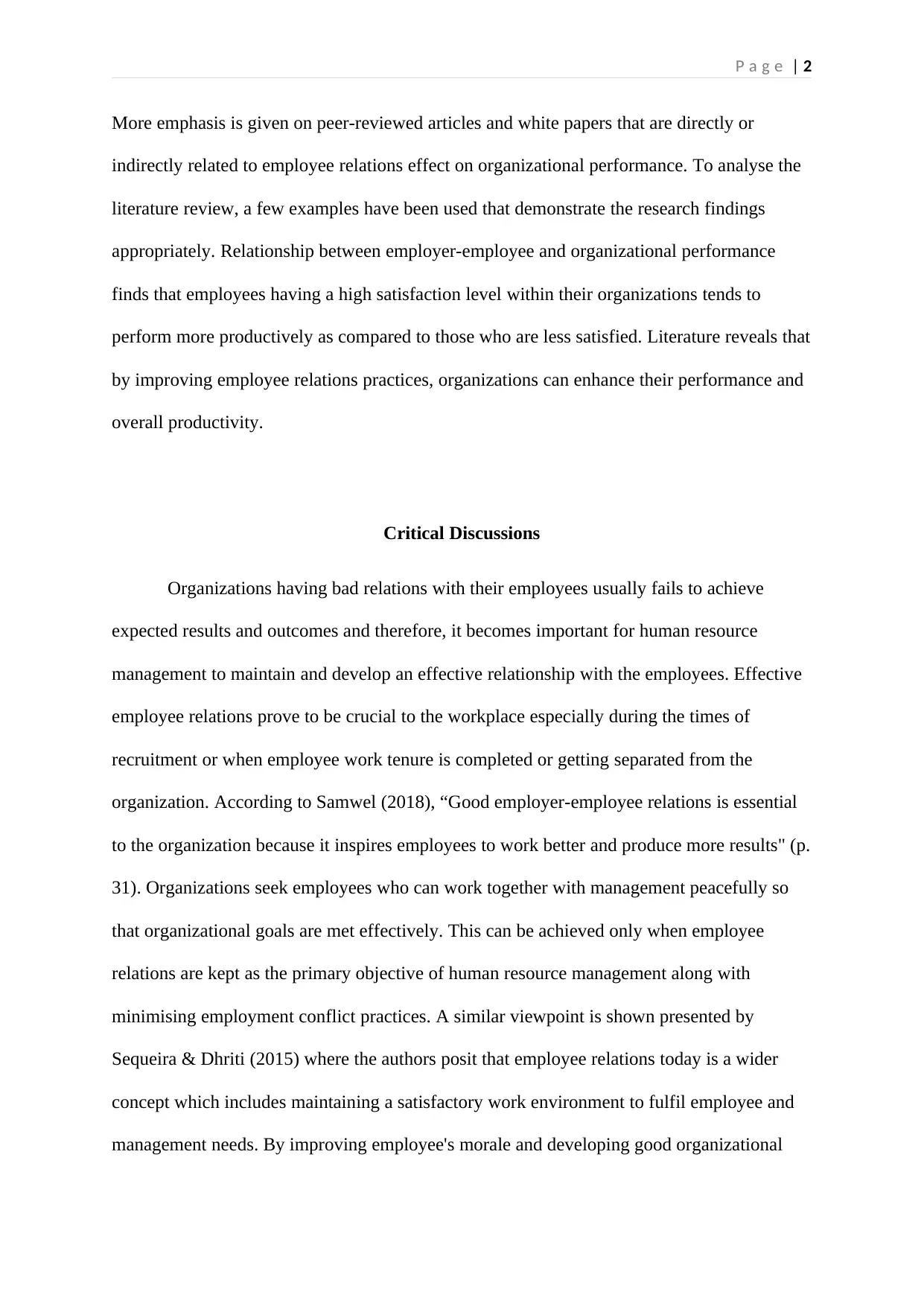
P a g e | 2
More emphasis is given on peer-reviewed articles and white papers that are directly or
indirectly related to employee relations effect on organizational performance. To analyse the
literature review, a few examples have been used that demonstrate the research findings
appropriately. Relationship between employer-employee and organizational performance
finds that employees having a high satisfaction level within their organizations tends to
perform more productively as compared to those who are less satisfied. Literature reveals that
by improving employee relations practices, organizations can enhance their performance and
overall productivity.
Critical Discussions
Organizations having bad relations with their employees usually fails to achieve
expected results and outcomes and therefore, it becomes important for human resource
management to maintain and develop an effective relationship with the employees. Effective
employee relations prove to be crucial to the workplace especially during the times of
recruitment or when employee work tenure is completed or getting separated from the
organization. According to Samwel (2018), “Good employer-employee relations is essential
to the organization because it inspires employees to work better and produce more results" (p.
31). Organizations seek employees who can work together with management peacefully so
that organizational goals are met effectively. This can be achieved only when employee
relations are kept as the primary objective of human resource management along with
minimising employment conflict practices. A similar viewpoint is shown presented by
Sequeira & Dhriti (2015) where the authors posit that employee relations today is a wider
concept which includes maintaining a satisfactory work environment to fulfil employee and
management needs. By improving employee's morale and developing good organizational
More emphasis is given on peer-reviewed articles and white papers that are directly or
indirectly related to employee relations effect on organizational performance. To analyse the
literature review, a few examples have been used that demonstrate the research findings
appropriately. Relationship between employer-employee and organizational performance
finds that employees having a high satisfaction level within their organizations tends to
perform more productively as compared to those who are less satisfied. Literature reveals that
by improving employee relations practices, organizations can enhance their performance and
overall productivity.
Critical Discussions
Organizations having bad relations with their employees usually fails to achieve
expected results and outcomes and therefore, it becomes important for human resource
management to maintain and develop an effective relationship with the employees. Effective
employee relations prove to be crucial to the workplace especially during the times of
recruitment or when employee work tenure is completed or getting separated from the
organization. According to Samwel (2018), “Good employer-employee relations is essential
to the organization because it inspires employees to work better and produce more results" (p.
31). Organizations seek employees who can work together with management peacefully so
that organizational goals are met effectively. This can be achieved only when employee
relations are kept as the primary objective of human resource management along with
minimising employment conflict practices. A similar viewpoint is shown presented by
Sequeira & Dhriti (2015) where the authors posit that employee relations today is a wider
concept which includes maintaining a satisfactory work environment to fulfil employee and
management needs. By improving employee's morale and developing good organizational
⊘ This is a preview!⊘
Do you want full access?
Subscribe today to unlock all pages.

Trusted by 1+ million students worldwide
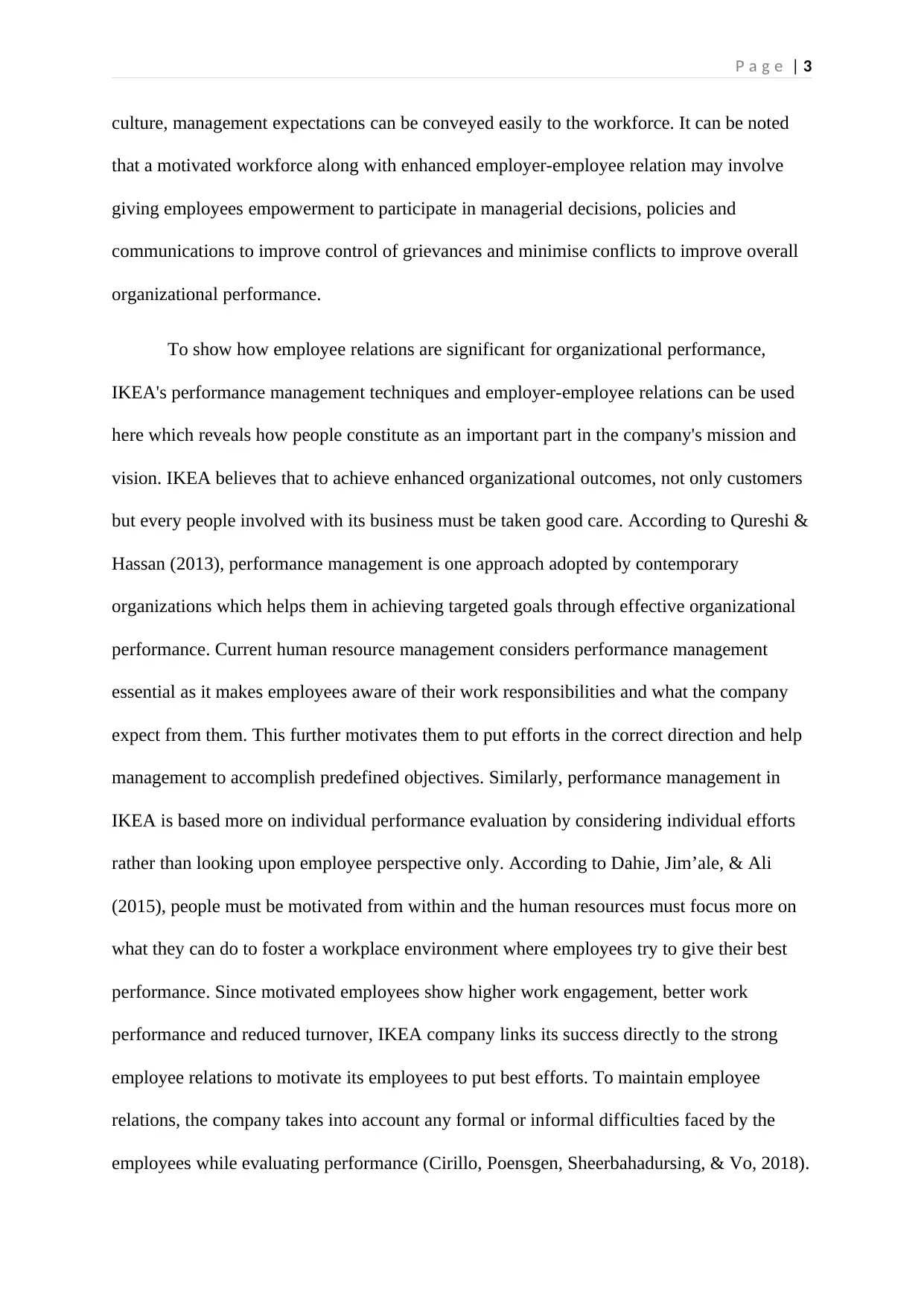
P a g e | 3
culture, management expectations can be conveyed easily to the workforce. It can be noted
that a motivated workforce along with enhanced employer-employee relation may involve
giving employees empowerment to participate in managerial decisions, policies and
communications to improve control of grievances and minimise conflicts to improve overall
organizational performance.
To show how employee relations are significant for organizational performance,
IKEA's performance management techniques and employer-employee relations can be used
here which reveals how people constitute as an important part in the company's mission and
vision. IKEA believes that to achieve enhanced organizational outcomes, not only customers
but every people involved with its business must be taken good care. According to Qureshi &
Hassan (2013), performance management is one approach adopted by contemporary
organizations which helps them in achieving targeted goals through effective organizational
performance. Current human resource management considers performance management
essential as it makes employees aware of their work responsibilities and what the company
expect from them. This further motivates them to put efforts in the correct direction and help
management to accomplish predefined objectives. Similarly, performance management in
IKEA is based more on individual performance evaluation by considering individual efforts
rather than looking upon employee perspective only. According to Dahie, Jim’ale, & Ali
(2015), people must be motivated from within and the human resources must focus more on
what they can do to foster a workplace environment where employees try to give their best
performance. Since motivated employees show higher work engagement, better work
performance and reduced turnover, IKEA company links its success directly to the strong
employee relations to motivate its employees to put best efforts. To maintain employee
relations, the company takes into account any formal or informal difficulties faced by the
employees while evaluating performance (Cirillo, Poensgen, Sheerbahadursing, & Vo, 2018).
culture, management expectations can be conveyed easily to the workforce. It can be noted
that a motivated workforce along with enhanced employer-employee relation may involve
giving employees empowerment to participate in managerial decisions, policies and
communications to improve control of grievances and minimise conflicts to improve overall
organizational performance.
To show how employee relations are significant for organizational performance,
IKEA's performance management techniques and employer-employee relations can be used
here which reveals how people constitute as an important part in the company's mission and
vision. IKEA believes that to achieve enhanced organizational outcomes, not only customers
but every people involved with its business must be taken good care. According to Qureshi &
Hassan (2013), performance management is one approach adopted by contemporary
organizations which helps them in achieving targeted goals through effective organizational
performance. Current human resource management considers performance management
essential as it makes employees aware of their work responsibilities and what the company
expect from them. This further motivates them to put efforts in the correct direction and help
management to accomplish predefined objectives. Similarly, performance management in
IKEA is based more on individual performance evaluation by considering individual efforts
rather than looking upon employee perspective only. According to Dahie, Jim’ale, & Ali
(2015), people must be motivated from within and the human resources must focus more on
what they can do to foster a workplace environment where employees try to give their best
performance. Since motivated employees show higher work engagement, better work
performance and reduced turnover, IKEA company links its success directly to the strong
employee relations to motivate its employees to put best efforts. To maintain employee
relations, the company takes into account any formal or informal difficulties faced by the
employees while evaluating performance (Cirillo, Poensgen, Sheerbahadursing, & Vo, 2018).
Paraphrase This Document
Need a fresh take? Get an instant paraphrase of this document with our AI Paraphraser
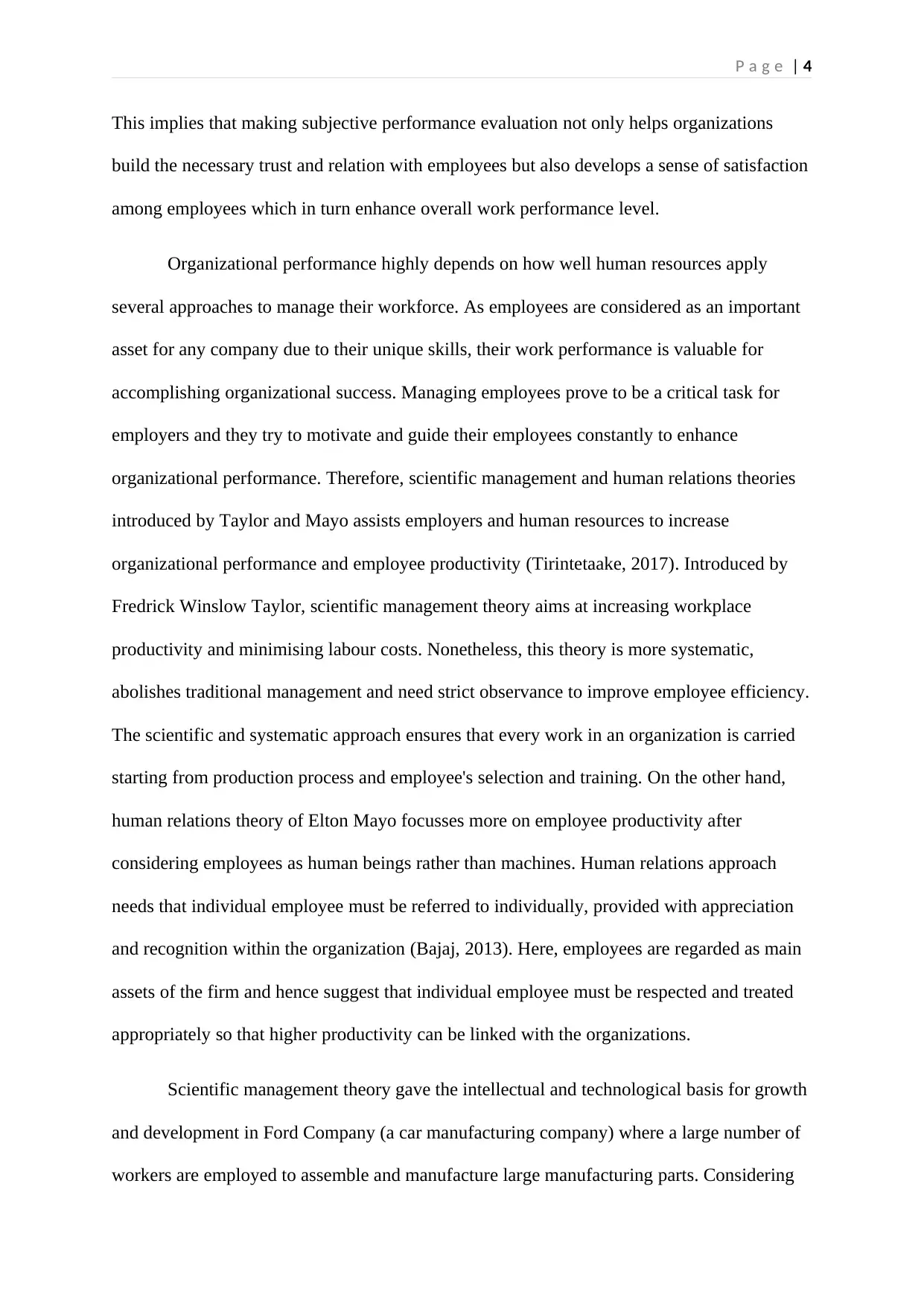
P a g e | 4
This implies that making subjective performance evaluation not only helps organizations
build the necessary trust and relation with employees but also develops a sense of satisfaction
among employees which in turn enhance overall work performance level.
Organizational performance highly depends on how well human resources apply
several approaches to manage their workforce. As employees are considered as an important
asset for any company due to their unique skills, their work performance is valuable for
accomplishing organizational success. Managing employees prove to be a critical task for
employers and they try to motivate and guide their employees constantly to enhance
organizational performance. Therefore, scientific management and human relations theories
introduced by Taylor and Mayo assists employers and human resources to increase
organizational performance and employee productivity (Tirintetaake, 2017). Introduced by
Fredrick Winslow Taylor, scientific management theory aims at increasing workplace
productivity and minimising labour costs. Nonetheless, this theory is more systematic,
abolishes traditional management and need strict observance to improve employee efficiency.
The scientific and systematic approach ensures that every work in an organization is carried
starting from production process and employee's selection and training. On the other hand,
human relations theory of Elton Mayo focusses more on employee productivity after
considering employees as human beings rather than machines. Human relations approach
needs that individual employee must be referred to individually, provided with appreciation
and recognition within the organization (Bajaj, 2013). Here, employees are regarded as main
assets of the firm and hence suggest that individual employee must be respected and treated
appropriately so that higher productivity can be linked with the organizations.
Scientific management theory gave the intellectual and technological basis for growth
and development in Ford Company (a car manufacturing company) where a large number of
workers are employed to assemble and manufacture large manufacturing parts. Considering
This implies that making subjective performance evaluation not only helps organizations
build the necessary trust and relation with employees but also develops a sense of satisfaction
among employees which in turn enhance overall work performance level.
Organizational performance highly depends on how well human resources apply
several approaches to manage their workforce. As employees are considered as an important
asset for any company due to their unique skills, their work performance is valuable for
accomplishing organizational success. Managing employees prove to be a critical task for
employers and they try to motivate and guide their employees constantly to enhance
organizational performance. Therefore, scientific management and human relations theories
introduced by Taylor and Mayo assists employers and human resources to increase
organizational performance and employee productivity (Tirintetaake, 2017). Introduced by
Fredrick Winslow Taylor, scientific management theory aims at increasing workplace
productivity and minimising labour costs. Nonetheless, this theory is more systematic,
abolishes traditional management and need strict observance to improve employee efficiency.
The scientific and systematic approach ensures that every work in an organization is carried
starting from production process and employee's selection and training. On the other hand,
human relations theory of Elton Mayo focusses more on employee productivity after
considering employees as human beings rather than machines. Human relations approach
needs that individual employee must be referred to individually, provided with appreciation
and recognition within the organization (Bajaj, 2013). Here, employees are regarded as main
assets of the firm and hence suggest that individual employee must be respected and treated
appropriately so that higher productivity can be linked with the organizations.
Scientific management theory gave the intellectual and technological basis for growth
and development in Ford Company (a car manufacturing company) where a large number of
workers are employed to assemble and manufacture large manufacturing parts. Considering
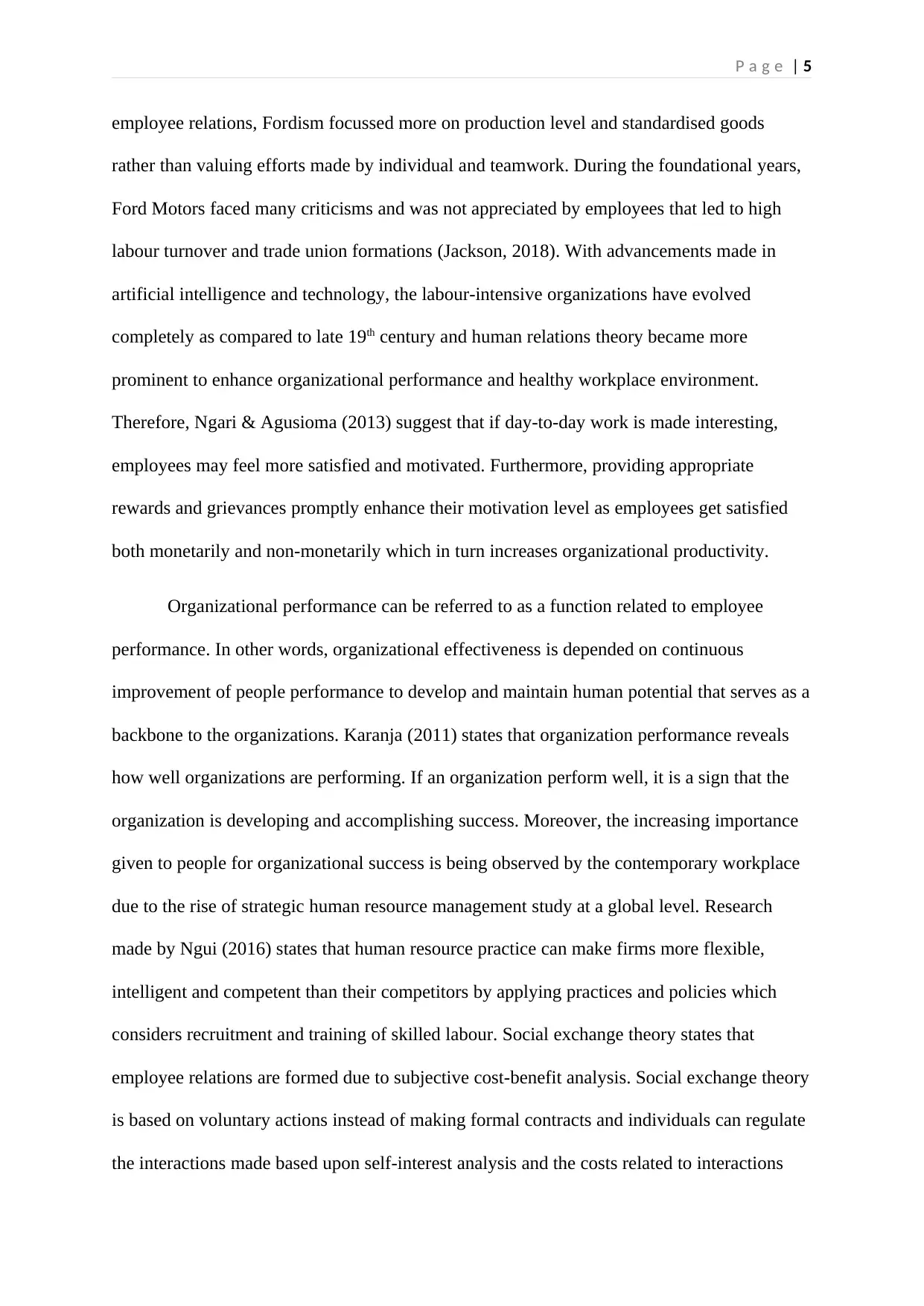
P a g e | 5
employee relations, Fordism focussed more on production level and standardised goods
rather than valuing efforts made by individual and teamwork. During the foundational years,
Ford Motors faced many criticisms and was not appreciated by employees that led to high
labour turnover and trade union formations (Jackson, 2018). With advancements made in
artificial intelligence and technology, the labour-intensive organizations have evolved
completely as compared to late 19th century and human relations theory became more
prominent to enhance organizational performance and healthy workplace environment.
Therefore, Ngari & Agusioma (2013) suggest that if day-to-day work is made interesting,
employees may feel more satisfied and motivated. Furthermore, providing appropriate
rewards and grievances promptly enhance their motivation level as employees get satisfied
both monetarily and non-monetarily which in turn increases organizational productivity.
Organizational performance can be referred to as a function related to employee
performance. In other words, organizational effectiveness is depended on continuous
improvement of people performance to develop and maintain human potential that serves as a
backbone to the organizations. Karanja (2011) states that organization performance reveals
how well organizations are performing. If an organization perform well, it is a sign that the
organization is developing and accomplishing success. Moreover, the increasing importance
given to people for organizational success is being observed by the contemporary workplace
due to the rise of strategic human resource management study at a global level. Research
made by Ngui (2016) states that human resource practice can make firms more flexible,
intelligent and competent than their competitors by applying practices and policies which
considers recruitment and training of skilled labour. Social exchange theory states that
employee relations are formed due to subjective cost-benefit analysis. Social exchange theory
is based on voluntary actions instead of making formal contracts and individuals can regulate
the interactions made based upon self-interest analysis and the costs related to interactions
employee relations, Fordism focussed more on production level and standardised goods
rather than valuing efforts made by individual and teamwork. During the foundational years,
Ford Motors faced many criticisms and was not appreciated by employees that led to high
labour turnover and trade union formations (Jackson, 2018). With advancements made in
artificial intelligence and technology, the labour-intensive organizations have evolved
completely as compared to late 19th century and human relations theory became more
prominent to enhance organizational performance and healthy workplace environment.
Therefore, Ngari & Agusioma (2013) suggest that if day-to-day work is made interesting,
employees may feel more satisfied and motivated. Furthermore, providing appropriate
rewards and grievances promptly enhance their motivation level as employees get satisfied
both monetarily and non-monetarily which in turn increases organizational productivity.
Organizational performance can be referred to as a function related to employee
performance. In other words, organizational effectiveness is depended on continuous
improvement of people performance to develop and maintain human potential that serves as a
backbone to the organizations. Karanja (2011) states that organization performance reveals
how well organizations are performing. If an organization perform well, it is a sign that the
organization is developing and accomplishing success. Moreover, the increasing importance
given to people for organizational success is being observed by the contemporary workplace
due to the rise of strategic human resource management study at a global level. Research
made by Ngui (2016) states that human resource practice can make firms more flexible,
intelligent and competent than their competitors by applying practices and policies which
considers recruitment and training of skilled labour. Social exchange theory states that
employee relations are formed due to subjective cost-benefit analysis. Social exchange theory
is based on voluntary actions instead of making formal contracts and individuals can regulate
the interactions made based upon self-interest analysis and the costs related to interactions
⊘ This is a preview!⊘
Do you want full access?
Subscribe today to unlock all pages.

Trusted by 1+ million students worldwide
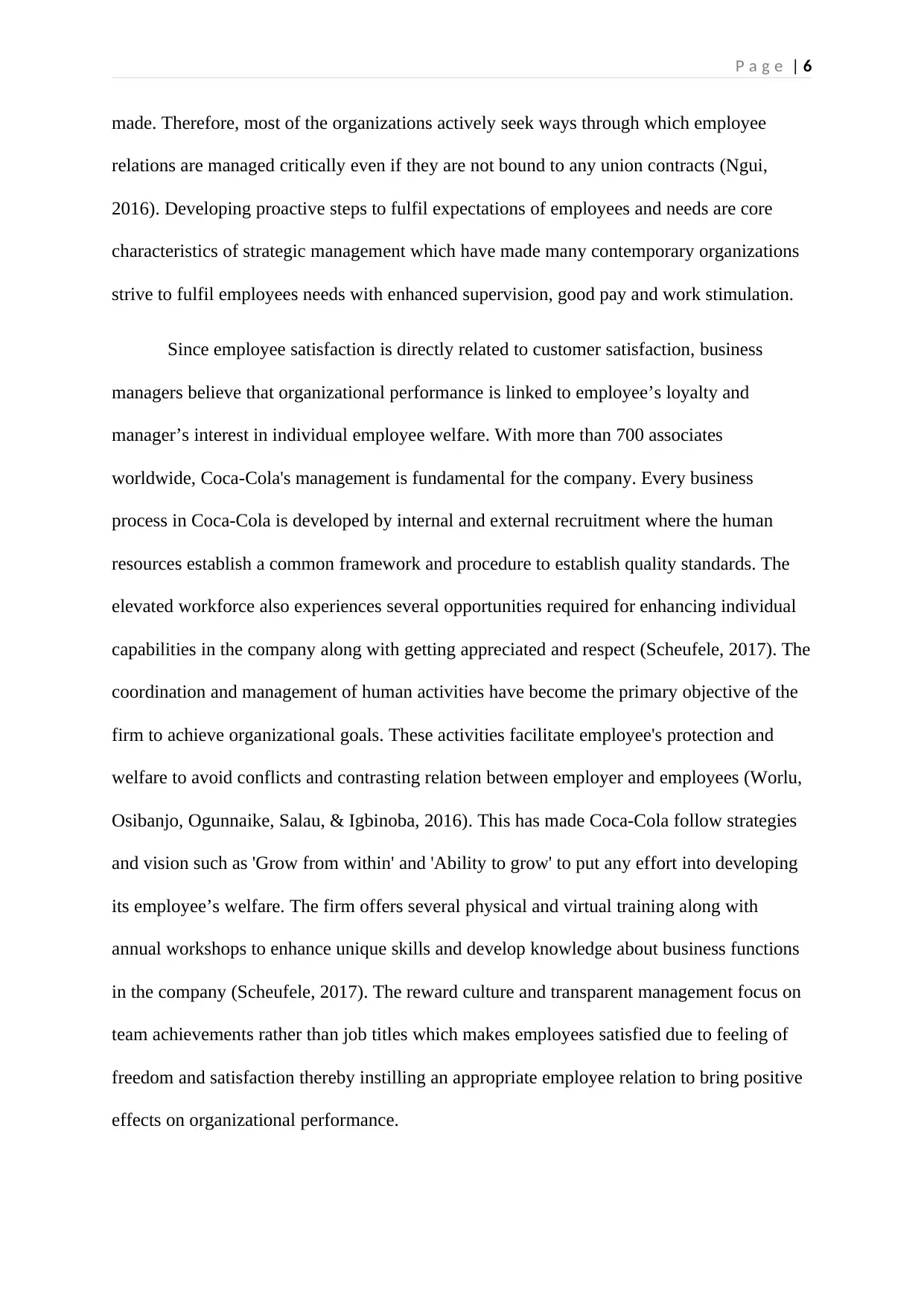
P a g e | 6
made. Therefore, most of the organizations actively seek ways through which employee
relations are managed critically even if they are not bound to any union contracts (Ngui,
2016). Developing proactive steps to fulfil expectations of employees and needs are core
characteristics of strategic management which have made many contemporary organizations
strive to fulfil employees needs with enhanced supervision, good pay and work stimulation.
Since employee satisfaction is directly related to customer satisfaction, business
managers believe that organizational performance is linked to employee’s loyalty and
manager’s interest in individual employee welfare. With more than 700 associates
worldwide, Coca-Cola's management is fundamental for the company. Every business
process in Coca-Cola is developed by internal and external recruitment where the human
resources establish a common framework and procedure to establish quality standards. The
elevated workforce also experiences several opportunities required for enhancing individual
capabilities in the company along with getting appreciated and respect (Scheufele, 2017). The
coordination and management of human activities have become the primary objective of the
firm to achieve organizational goals. These activities facilitate employee's protection and
welfare to avoid conflicts and contrasting relation between employer and employees (Worlu,
Osibanjo, Ogunnaike, Salau, & Igbinoba, 2016). This has made Coca-Cola follow strategies
and vision such as 'Grow from within' and 'Ability to grow' to put any effort into developing
its employee’s welfare. The firm offers several physical and virtual training along with
annual workshops to enhance unique skills and develop knowledge about business functions
in the company (Scheufele, 2017). The reward culture and transparent management focus on
team achievements rather than job titles which makes employees satisfied due to feeling of
freedom and satisfaction thereby instilling an appropriate employee relation to bring positive
effects on organizational performance.
made. Therefore, most of the organizations actively seek ways through which employee
relations are managed critically even if they are not bound to any union contracts (Ngui,
2016). Developing proactive steps to fulfil expectations of employees and needs are core
characteristics of strategic management which have made many contemporary organizations
strive to fulfil employees needs with enhanced supervision, good pay and work stimulation.
Since employee satisfaction is directly related to customer satisfaction, business
managers believe that organizational performance is linked to employee’s loyalty and
manager’s interest in individual employee welfare. With more than 700 associates
worldwide, Coca-Cola's management is fundamental for the company. Every business
process in Coca-Cola is developed by internal and external recruitment where the human
resources establish a common framework and procedure to establish quality standards. The
elevated workforce also experiences several opportunities required for enhancing individual
capabilities in the company along with getting appreciated and respect (Scheufele, 2017). The
coordination and management of human activities have become the primary objective of the
firm to achieve organizational goals. These activities facilitate employee's protection and
welfare to avoid conflicts and contrasting relation between employer and employees (Worlu,
Osibanjo, Ogunnaike, Salau, & Igbinoba, 2016). This has made Coca-Cola follow strategies
and vision such as 'Grow from within' and 'Ability to grow' to put any effort into developing
its employee’s welfare. The firm offers several physical and virtual training along with
annual workshops to enhance unique skills and develop knowledge about business functions
in the company (Scheufele, 2017). The reward culture and transparent management focus on
team achievements rather than job titles which makes employees satisfied due to feeling of
freedom and satisfaction thereby instilling an appropriate employee relation to bring positive
effects on organizational performance.
Paraphrase This Document
Need a fresh take? Get an instant paraphrase of this document with our AI Paraphraser
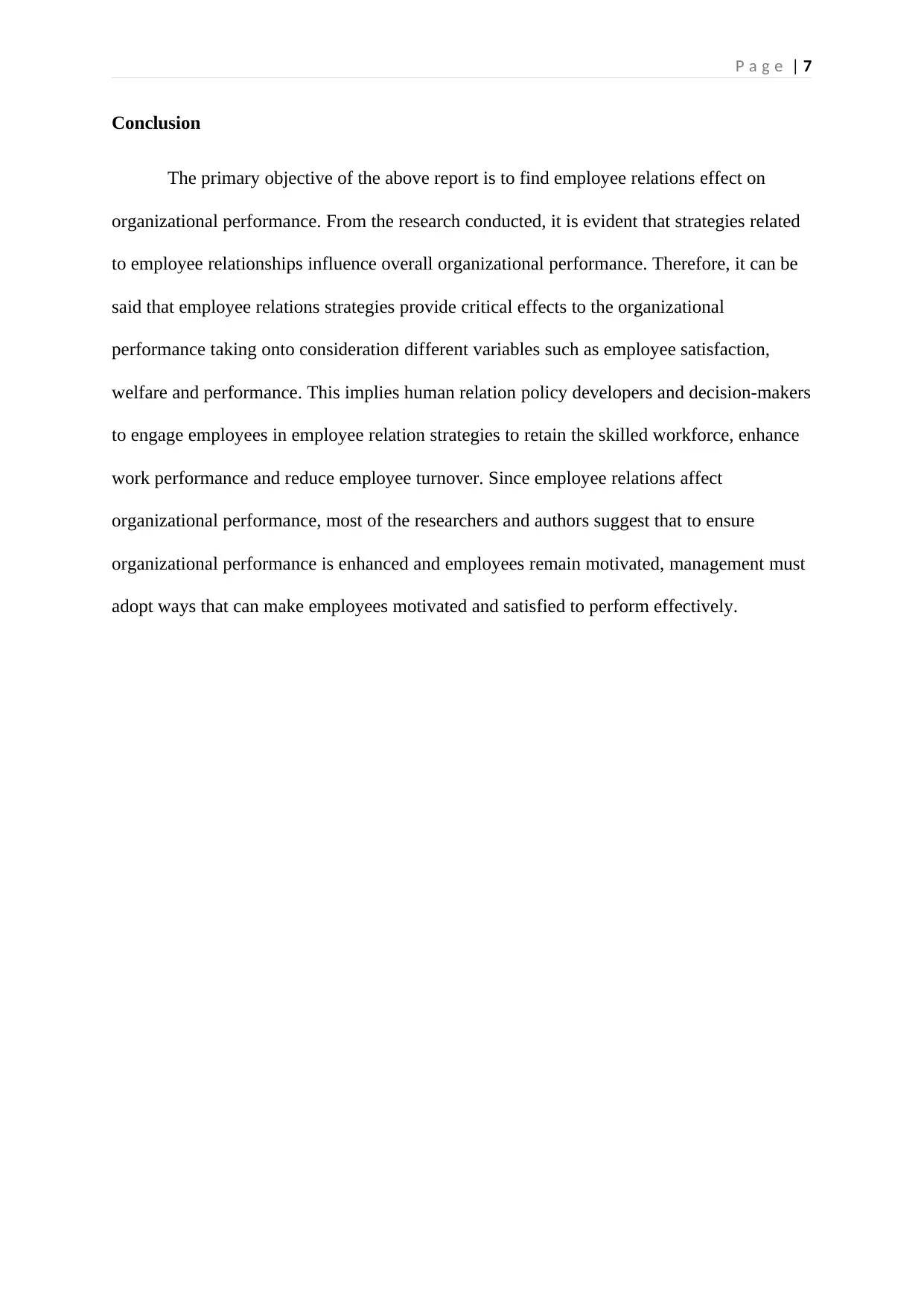
P a g e | 7
Conclusion
The primary objective of the above report is to find employee relations effect on
organizational performance. From the research conducted, it is evident that strategies related
to employee relationships influence overall organizational performance. Therefore, it can be
said that employee relations strategies provide critical effects to the organizational
performance taking onto consideration different variables such as employee satisfaction,
welfare and performance. This implies human relation policy developers and decision-makers
to engage employees in employee relation strategies to retain the skilled workforce, enhance
work performance and reduce employee turnover. Since employee relations affect
organizational performance, most of the researchers and authors suggest that to ensure
organizational performance is enhanced and employees remain motivated, management must
adopt ways that can make employees motivated and satisfied to perform effectively.
Conclusion
The primary objective of the above report is to find employee relations effect on
organizational performance. From the research conducted, it is evident that strategies related
to employee relationships influence overall organizational performance. Therefore, it can be
said that employee relations strategies provide critical effects to the organizational
performance taking onto consideration different variables such as employee satisfaction,
welfare and performance. This implies human relation policy developers and decision-makers
to engage employees in employee relation strategies to retain the skilled workforce, enhance
work performance and reduce employee turnover. Since employee relations affect
organizational performance, most of the researchers and authors suggest that to ensure
organizational performance is enhanced and employees remain motivated, management must
adopt ways that can make employees motivated and satisfied to perform effectively.
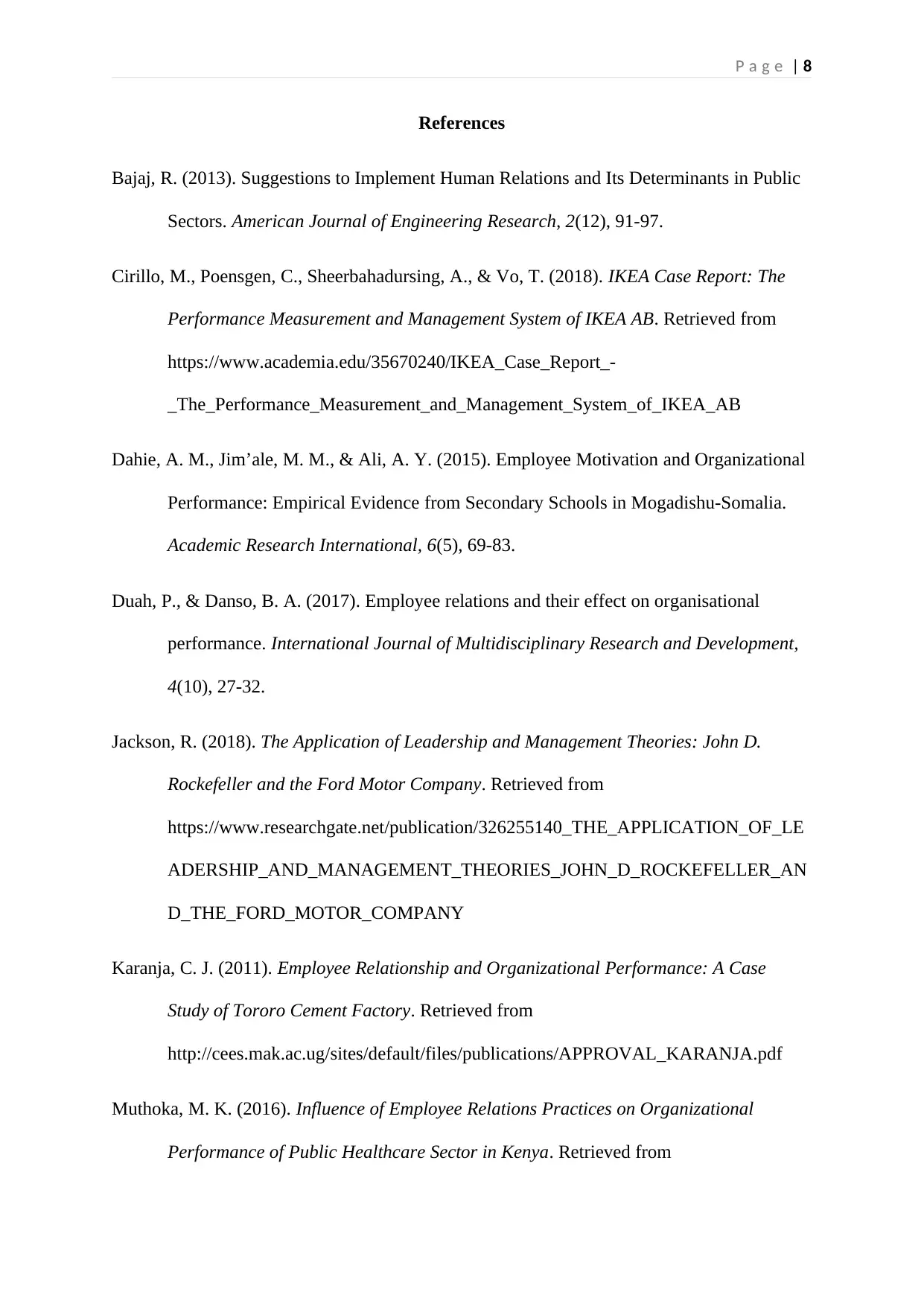
P a g e | 8
References
Bajaj, R. (2013). Suggestions to Implement Human Relations and Its Determinants in Public
Sectors. American Journal of Engineering Research, 2(12), 91-97.
Cirillo, M., Poensgen, C., Sheerbahadursing, A., & Vo, T. (2018). IKEA Case Report: The
Performance Measurement and Management System of IKEA AB. Retrieved from
https://www.academia.edu/35670240/IKEA_Case_Report_-
_The_Performance_Measurement_and_Management_System_of_IKEA_AB
Dahie, A. M., Jim’ale, M. M., & Ali, A. Y. (2015). Employee Motivation and Organizational
Performance: Empirical Evidence from Secondary Schools in Mogadishu-Somalia.
Academic Research International, 6(5), 69-83.
Duah, P., & Danso, B. A. (2017). Employee relations and their effect on organisational
performance. International Journal of Multidisciplinary Research and Development,
4(10), 27-32.
Jackson, R. (2018). The Application of Leadership and Management Theories: John D.
Rockefeller and the Ford Motor Company. Retrieved from
https://www.researchgate.net/publication/326255140_THE_APPLICATION_OF_LE
ADERSHIP_AND_MANAGEMENT_THEORIES_JOHN_D_ROCKEFELLER_AN
D_THE_FORD_MOTOR_COMPANY
Karanja, C. J. (2011). Employee Relationship and Organizational Performance: A Case
Study of Tororo Cement Factory. Retrieved from
http://cees.mak.ac.ug/sites/default/files/publications/APPROVAL_KARANJA.pdf
Muthoka, M. K. (2016). Influence of Employee Relations Practices on Organizational
Performance of Public Healthcare Sector in Kenya. Retrieved from
References
Bajaj, R. (2013). Suggestions to Implement Human Relations and Its Determinants in Public
Sectors. American Journal of Engineering Research, 2(12), 91-97.
Cirillo, M., Poensgen, C., Sheerbahadursing, A., & Vo, T. (2018). IKEA Case Report: The
Performance Measurement and Management System of IKEA AB. Retrieved from
https://www.academia.edu/35670240/IKEA_Case_Report_-
_The_Performance_Measurement_and_Management_System_of_IKEA_AB
Dahie, A. M., Jim’ale, M. M., & Ali, A. Y. (2015). Employee Motivation and Organizational
Performance: Empirical Evidence from Secondary Schools in Mogadishu-Somalia.
Academic Research International, 6(5), 69-83.
Duah, P., & Danso, B. A. (2017). Employee relations and their effect on organisational
performance. International Journal of Multidisciplinary Research and Development,
4(10), 27-32.
Jackson, R. (2018). The Application of Leadership and Management Theories: John D.
Rockefeller and the Ford Motor Company. Retrieved from
https://www.researchgate.net/publication/326255140_THE_APPLICATION_OF_LE
ADERSHIP_AND_MANAGEMENT_THEORIES_JOHN_D_ROCKEFELLER_AN
D_THE_FORD_MOTOR_COMPANY
Karanja, C. J. (2011). Employee Relationship and Organizational Performance: A Case
Study of Tororo Cement Factory. Retrieved from
http://cees.mak.ac.ug/sites/default/files/publications/APPROVAL_KARANJA.pdf
Muthoka, M. K. (2016). Influence of Employee Relations Practices on Organizational
Performance of Public Healthcare Sector in Kenya. Retrieved from
⊘ This is a preview!⊘
Do you want full access?
Subscribe today to unlock all pages.

Trusted by 1+ million students worldwide
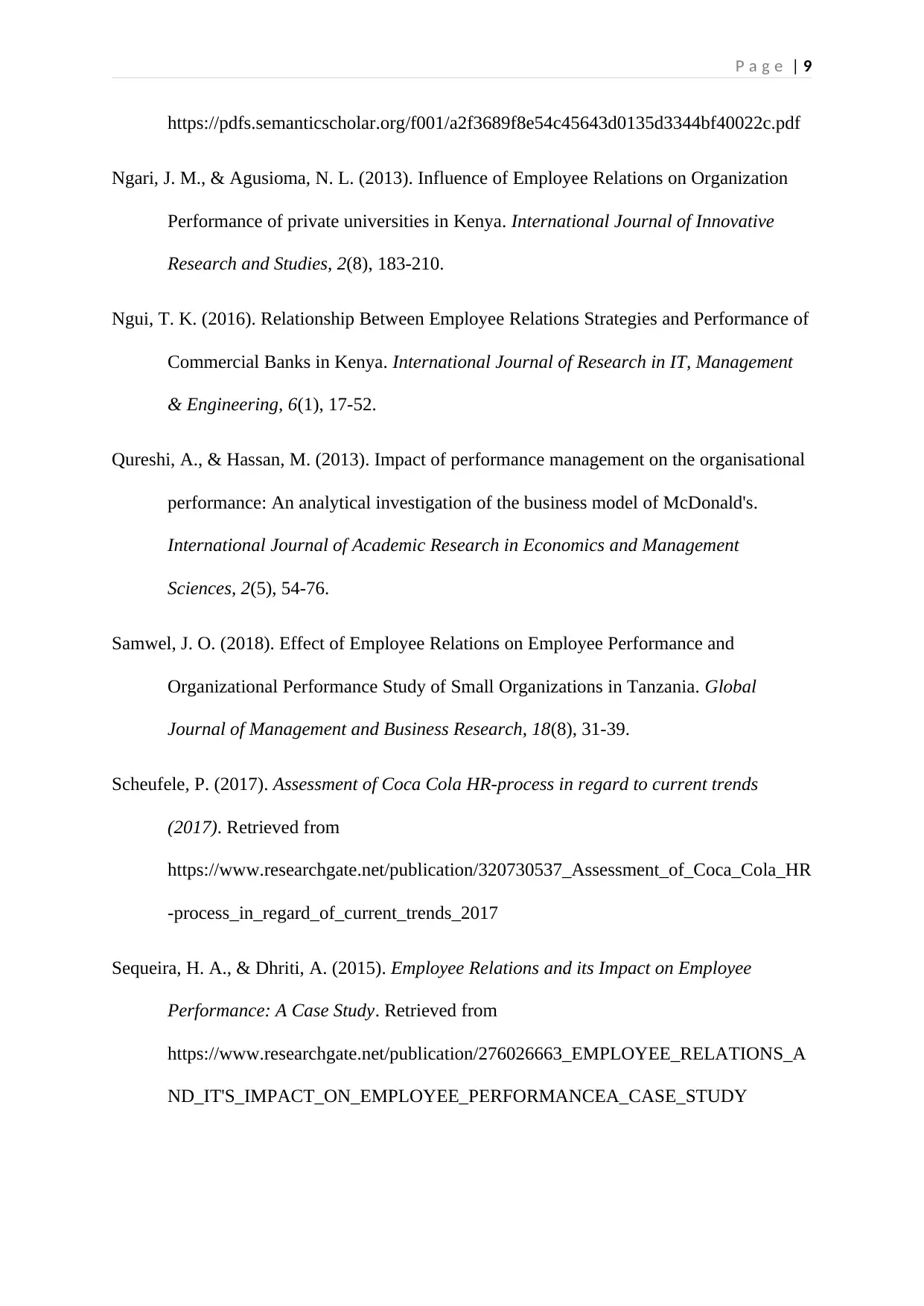
P a g e | 9
https://pdfs.semanticscholar.org/f001/a2f3689f8e54c45643d0135d3344bf40022c.pdf
Ngari, J. M., & Agusioma, N. L. (2013). Influence of Employee Relations on Organization
Performance of private universities in Kenya. International Journal of Innovative
Research and Studies, 2(8), 183-210.
Ngui, T. K. (2016). Relationship Between Employee Relations Strategies and Performance of
Commercial Banks in Kenya. International Journal of Research in IT, Management
& Engineering, 6(1), 17-52.
Qureshi, A., & Hassan, M. (2013). Impact of performance management on the organisational
performance: An analytical investigation of the business model of McDonald's.
International Journal of Academic Research in Economics and Management
Sciences, 2(5), 54-76.
Samwel, J. O. (2018). Effect of Employee Relations on Employee Performance and
Organizational Performance Study of Small Organizations in Tanzania. Global
Journal of Management and Business Research, 18(8), 31-39.
Scheufele, P. (2017). Assessment of Coca Cola HR-process in regard to current trends
(2017). Retrieved from
https://www.researchgate.net/publication/320730537_Assessment_of_Coca_Cola_HR
-process_in_regard_of_current_trends_2017
Sequeira, H. A., & Dhriti, A. (2015). Employee Relations and its Impact on Employee
Performance: A Case Study. Retrieved from
https://www.researchgate.net/publication/276026663_EMPLOYEE_RELATIONS_A
ND_IT'S_IMPACT_ON_EMPLOYEE_PERFORMANCEA_CASE_STUDY
https://pdfs.semanticscholar.org/f001/a2f3689f8e54c45643d0135d3344bf40022c.pdf
Ngari, J. M., & Agusioma, N. L. (2013). Influence of Employee Relations on Organization
Performance of private universities in Kenya. International Journal of Innovative
Research and Studies, 2(8), 183-210.
Ngui, T. K. (2016). Relationship Between Employee Relations Strategies and Performance of
Commercial Banks in Kenya. International Journal of Research in IT, Management
& Engineering, 6(1), 17-52.
Qureshi, A., & Hassan, M. (2013). Impact of performance management on the organisational
performance: An analytical investigation of the business model of McDonald's.
International Journal of Academic Research in Economics and Management
Sciences, 2(5), 54-76.
Samwel, J. O. (2018). Effect of Employee Relations on Employee Performance and
Organizational Performance Study of Small Organizations in Tanzania. Global
Journal of Management and Business Research, 18(8), 31-39.
Scheufele, P. (2017). Assessment of Coca Cola HR-process in regard to current trends
(2017). Retrieved from
https://www.researchgate.net/publication/320730537_Assessment_of_Coca_Cola_HR
-process_in_regard_of_current_trends_2017
Sequeira, H. A., & Dhriti, A. (2015). Employee Relations and its Impact on Employee
Performance: A Case Study. Retrieved from
https://www.researchgate.net/publication/276026663_EMPLOYEE_RELATIONS_A
ND_IT'S_IMPACT_ON_EMPLOYEE_PERFORMANCEA_CASE_STUDY
Paraphrase This Document
Need a fresh take? Get an instant paraphrase of this document with our AI Paraphraser
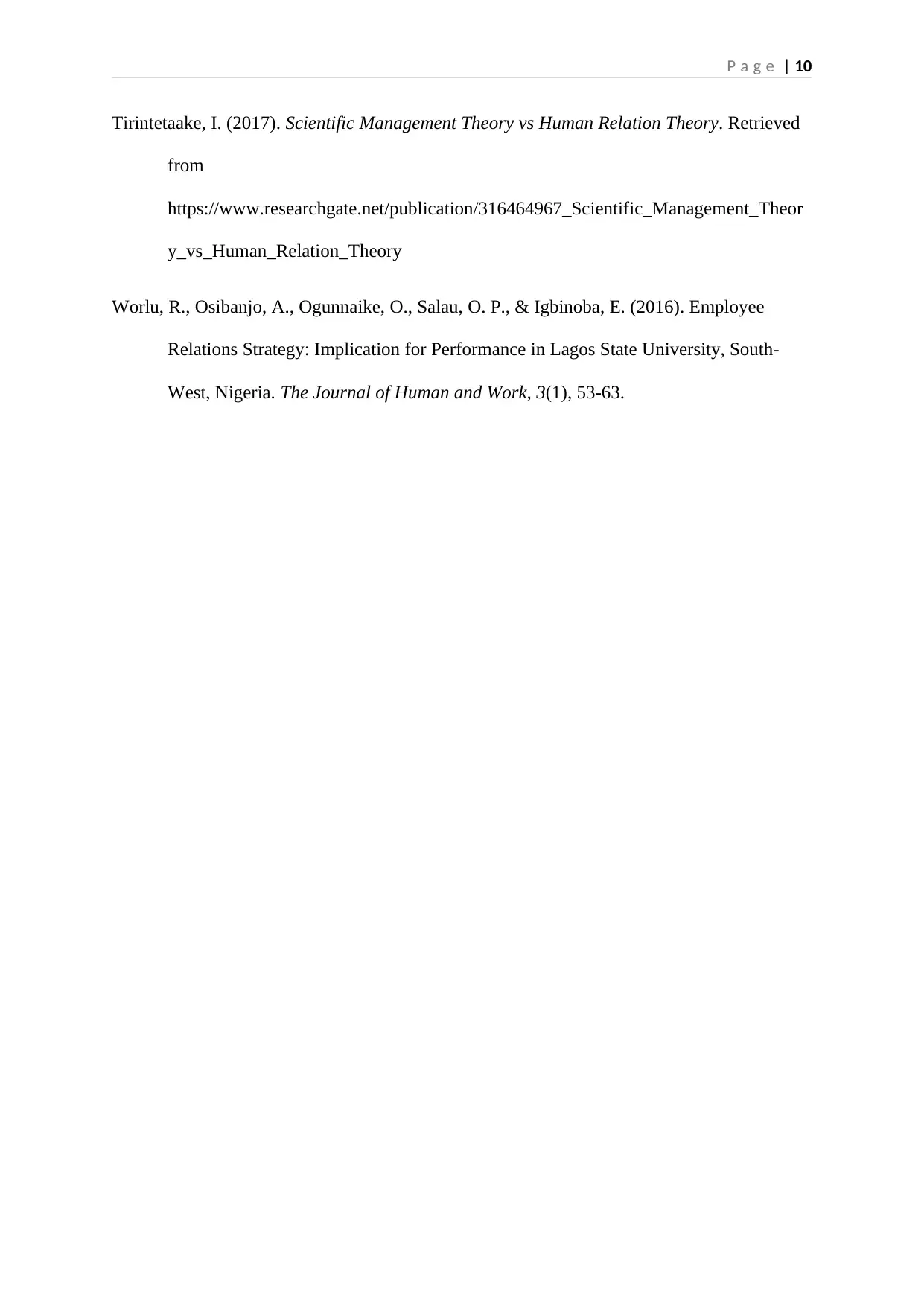
P a g e | 10
Tirintetaake, I. (2017). Scientific Management Theory vs Human Relation Theory. Retrieved
from
https://www.researchgate.net/publication/316464967_Scientific_Management_Theor
y_vs_Human_Relation_Theory
Worlu, R., Osibanjo, A., Ogunnaike, O., Salau, O. P., & Igbinoba, E. (2016). Employee
Relations Strategy: Implication for Performance in Lagos State University, South-
West, Nigeria. The Journal of Human and Work, 3(1), 53-63.
Tirintetaake, I. (2017). Scientific Management Theory vs Human Relation Theory. Retrieved
from
https://www.researchgate.net/publication/316464967_Scientific_Management_Theor
y_vs_Human_Relation_Theory
Worlu, R., Osibanjo, A., Ogunnaike, O., Salau, O. P., & Igbinoba, E. (2016). Employee
Relations Strategy: Implication for Performance in Lagos State University, South-
West, Nigeria. The Journal of Human and Work, 3(1), 53-63.
1 out of 11
Related Documents
Your All-in-One AI-Powered Toolkit for Academic Success.
+13062052269
info@desklib.com
Available 24*7 on WhatsApp / Email
![[object Object]](/_next/static/media/star-bottom.7253800d.svg)
Unlock your academic potential
Copyright © 2020–2025 A2Z Services. All Rights Reserved. Developed and managed by ZUCOL.





